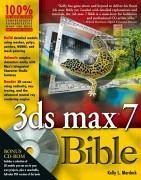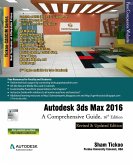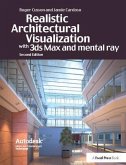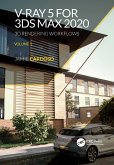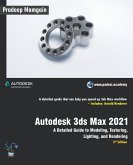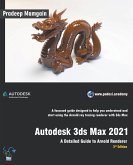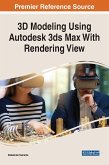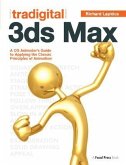Kelly L. Murdock
3ds max 7 Bible
Kelly L. Murdock
3ds max 7 Bible
- Broschiertes Buch
- Merkliste
- Auf die Merkliste
- Bewerten Bewerten
- Teilen
- Produkt teilen
- Produkterinnerung
- Produkterinnerung
* Packed with expert advice, timesaving tips, and more than 150 step-by-step tutorials, this book is a must for anyone who wants to master this complex, expensive software package * Offers full coverage of new software features and enhancements and shows users how to master everything from the Particle Flow interface and architectural objects and materials to Shockwave 3D Export and VertexPaint features * The companion CD-ROMs include a demo version of the new 3ds max, tutorial files, 3D models, bonus plug-ins, and more * 3ds max is used to create approximately eighty percent of the top video…mehr
Andere Kunden interessierten sich auch für
![Autodesk 3ds Max 2016 Autodesk 3ds Max 2016]() And Cadcim Technologies ShamAutodesk 3ds Max 2016131,99 €
And Cadcim Technologies ShamAutodesk 3ds Max 2016131,99 €![Realistic Architectural Rendering with 3ds Max and V-Ray Realistic Architectural Rendering with 3ds Max and V-Ray]() Jamie CardosoRealistic Architectural Rendering with 3ds Max and V-Ray173,99 €
Jamie CardosoRealistic Architectural Rendering with 3ds Max and V-Ray173,99 €![V-Ray 5 for 3ds Max 2020 V-Ray 5 for 3ds Max 2020]() Jamie CardosoV-Ray 5 for 3ds Max 2020212,99 €
Jamie CardosoV-Ray 5 for 3ds Max 2020212,99 €![Autodesk 3ds Max 2021 Autodesk 3ds Max 2021]() Pradeep MamgainAutodesk 3ds Max 202145,99 €
Pradeep MamgainAutodesk 3ds Max 202145,99 €![Autodesk 3ds Max 2021 Autodesk 3ds Max 2021]() Pradeep MamgainAutodesk 3ds Max 202128,99 €
Pradeep MamgainAutodesk 3ds Max 202128,99 €![3D Modeling Using Autodesk 3ds Max With Rendering View 3D Modeling Using Autodesk 3ds Max With Rendering View]() 3D Modeling Using Autodesk 3ds Max With Rendering View282,99 €
3D Modeling Using Autodesk 3ds Max With Rendering View282,99 €![Tradigital 3ds Max Tradigital 3ds Max]() Richard LapidusTradigital 3ds Max197,99 €
Richard LapidusTradigital 3ds Max197,99 €-
* Packed with expert advice, timesaving tips, and more than 150 step-by-step tutorials, this book is a must for anyone who wants to master this complex, expensive software package * Offers full coverage of new software features and enhancements and shows users how to master everything from the Particle Flow interface and architectural objects and materials to Shockwave 3D Export and VertexPaint features * The companion CD-ROMs include a demo version of the new 3ds max, tutorial files, 3D models, bonus plug-ins, and more * 3ds max is used to create approximately eighty percent of the top video games-including Grand Theft Auto 3-and is extensively employed for special effects in movies such as The Matrix Reloaded
Produktdetails
- Produktdetails
- Verlag: John Wiley & Sons / Wiley John + Sons
- Artikelnr. des Verlages: 19767971000
- Seitenzahl: 1296
- Englisch
- Abmessung: 233mm x 189mm x 50mm
- Gewicht: 1999g
- ISBN-13: 9780764579714
- ISBN-10: 0764579711
- Artikelnr.: 13476687
- Herstellerkennzeichnung
- Books on Demand GmbH
- In de Tarpen 42
- 22848 Norderstedt
- info@bod.de
- 040 53433511
- Verlag: John Wiley & Sons / Wiley John + Sons
- Artikelnr. des Verlages: 19767971000
- Seitenzahl: 1296
- Englisch
- Abmessung: 233mm x 189mm x 50mm
- Gewicht: 1999g
- ISBN-13: 9780764579714
- ISBN-10: 0764579711
- Artikelnr.: 13476687
- Herstellerkennzeichnung
- Books on Demand GmbH
- In de Tarpen 42
- 22848 Norderstedt
- info@bod.de
- 040 53433511
Kelly Murdock has been authoring computer books for many years now and still gets immense enjoyment from the completed work. His book credits include various Web, graphics, and multimedia titles, including four previous editions of this book, 3ds max 7 Bible. Other major accomplishments include Master VISUALLY HTML and XHTML, JavaScript Visual Blueprint, gmax Bible, Adobe Atmosphere Bible, Maya 6 Revealed, and co-authoring duties on two editions of the Illustrator Bible (for versions 9 and 10) and the Adobe Creative Suite Bible. With a background in engineering and computer graphics, Kelly has been all over the 3D industry and still finds it fascinating. He's used high-level CAD workstations for product design and analysis, completed several large-scale visualization projects, created 3D models for feature films, worked as a freelance 3D artist, and has even done some 3D programming. Kelly's been using 3D Studio since version 3 for DOS.
Preface. Acknowledgments. Part I: Learning the Max Interface. Quick Start:
Creating and Animating a Three-Fingered Gaaboot. Chapter 1: Finding Your
Way--Exploring the Max Interface. Chapter 2: Seeing It All--Working with
the Viewports. Chapter 3: Saving Your Scene--Working with Files and Xrefs.
Chapter 4: Customizing the Max Interface and Setting Preferences. Part II:
Working with Objects. Chapter 5: Creating and Editing Primitive Objects.
Chapter 6: Selecting Objects and Setting Object Properties. Chapter 7:
Transforming Objects--Translate, Rotate, and Scale. Chapter 8: Cloning
Objects and Creating Object Arrays. Chapter 9: Grouping and Linking
Objects. Chapter 10: Working with the Schematic View. Chapter 11:
Introducing Modifiers and Using the Modifier Stack. Part III: Modeling.
Chapter 12: Modeling Basics and Working with Subobjects. Chapter 13:
Drawing and Editing 2D Splines and Shapes. Chapter 14: Using Editable Poly
Objects. Chapter 15: Painting Deformations.1 Chapter 16: Working with Mesh
Modifiers. Chapter 17: Surface Modeling with Patches and NURBS. Chapter 18:
Building Compound Objects. Chapter 19: Creating Particles and Particle
Flow. Part IV: Materials and Maps. Chapter 20: Exploring the Material
Editor. Chapter 21: Creating Simple Materials. Chapter 22: Creating
Advanced Multi-Layer Materials. Chapter 23: Adding Material Details with
Maps. Chapter 24: Controlling Mapping Coordinates. Chapter 25: Creating
Baked Textures. Part V: Cameras and Lighting. Chatper 26: Working with
Cameras. Chapter 27: Basic Lighting Techniques. Chapter 28: Advanced
Lighting, Light Tracing, and Radiosity. Part VI: Animation. Chapter 29:
Animation and Keyframe Basics. Chapter 30: Using Animation Modifiers.
Chapter 31: Wiring Custom Attributes. Chapter 32: Animating with
Constraints and Controllers. Chapter 33: Using the Expression Controller.
Chapter 34: Working with the Track View.9 Part VII: Character Studio,
Rigging, and Inverse Kinematics. Chapter 35: Creating and Animating Bipeds.
Chapter 36: Using Physique to Add Skin to a Biped. Chapter 37: Controlling
Biped Crowds. Chapter 38: Manually Rigging a Character. Chapter 39: Working
with Inverse Kinematics.9 Part VIII: Dynamics and reactor. Chapter 40:
Using Space Warps. Chapter 41: Creating a Dynamic Simulation. Chapter 42:
Animating with reactor. Part IX: Rendering and mental ray. Chapter 43:
Rendering Basics. Chapter 44: Using Atmospheric Effects. Chapter 45: Using
Render Elements and Effects. Chapter 46: Raytracing and mental ray.7
Chapter 47: Network Rendering. Chapter 48: Using the Video Post Interface.
Part X: MAXScript and Plug-Ins. Chapter 49: Automating with MAXScript.
Chapter 50: Expanding Max with Third-Party Plug-Ins. Appendix A: What's New
with Max 7.1 Appendix B: Installing and Configuring 3ds max 7. Appendix C:
Max Keyboard Shortcuts. Appendix D: What's on the CD-ROM. Index. End-User
License Agreement.
Creating and Animating a Three-Fingered Gaaboot. Chapter 1: Finding Your
Way--Exploring the Max Interface. Chapter 2: Seeing It All--Working with
the Viewports. Chapter 3: Saving Your Scene--Working with Files and Xrefs.
Chapter 4: Customizing the Max Interface and Setting Preferences. Part II:
Working with Objects. Chapter 5: Creating and Editing Primitive Objects.
Chapter 6: Selecting Objects and Setting Object Properties. Chapter 7:
Transforming Objects--Translate, Rotate, and Scale. Chapter 8: Cloning
Objects and Creating Object Arrays. Chapter 9: Grouping and Linking
Objects. Chapter 10: Working with the Schematic View. Chapter 11:
Introducing Modifiers and Using the Modifier Stack. Part III: Modeling.
Chapter 12: Modeling Basics and Working with Subobjects. Chapter 13:
Drawing and Editing 2D Splines and Shapes. Chapter 14: Using Editable Poly
Objects. Chapter 15: Painting Deformations.1 Chapter 16: Working with Mesh
Modifiers. Chapter 17: Surface Modeling with Patches and NURBS. Chapter 18:
Building Compound Objects. Chapter 19: Creating Particles and Particle
Flow. Part IV: Materials and Maps. Chapter 20: Exploring the Material
Editor. Chapter 21: Creating Simple Materials. Chapter 22: Creating
Advanced Multi-Layer Materials. Chapter 23: Adding Material Details with
Maps. Chapter 24: Controlling Mapping Coordinates. Chapter 25: Creating
Baked Textures. Part V: Cameras and Lighting. Chatper 26: Working with
Cameras. Chapter 27: Basic Lighting Techniques. Chapter 28: Advanced
Lighting, Light Tracing, and Radiosity. Part VI: Animation. Chapter 29:
Animation and Keyframe Basics. Chapter 30: Using Animation Modifiers.
Chapter 31: Wiring Custom Attributes. Chapter 32: Animating with
Constraints and Controllers. Chapter 33: Using the Expression Controller.
Chapter 34: Working with the Track View.9 Part VII: Character Studio,
Rigging, and Inverse Kinematics. Chapter 35: Creating and Animating Bipeds.
Chapter 36: Using Physique to Add Skin to a Biped. Chapter 37: Controlling
Biped Crowds. Chapter 38: Manually Rigging a Character. Chapter 39: Working
with Inverse Kinematics.9 Part VIII: Dynamics and reactor. Chapter 40:
Using Space Warps. Chapter 41: Creating a Dynamic Simulation. Chapter 42:
Animating with reactor. Part IX: Rendering and mental ray. Chapter 43:
Rendering Basics. Chapter 44: Using Atmospheric Effects. Chapter 45: Using
Render Elements and Effects. Chapter 46: Raytracing and mental ray.7
Chapter 47: Network Rendering. Chapter 48: Using the Video Post Interface.
Part X: MAXScript and Plug-Ins. Chapter 49: Automating with MAXScript.
Chapter 50: Expanding Max with Third-Party Plug-Ins. Appendix A: What's New
with Max 7.1 Appendix B: Installing and Configuring 3ds max 7. Appendix C:
Max Keyboard Shortcuts. Appendix D: What's on the CD-ROM. Index. End-User
License Agreement.
Preface. Acknowledgments. Part I: Learning the Max Interface. Quick Start:
Creating and Animating a Three-Fingered Gaaboot. Chapter 1: Finding Your
Way--Exploring the Max Interface. Chapter 2: Seeing It All--Working with
the Viewports. Chapter 3: Saving Your Scene--Working with Files and Xrefs.
Chapter 4: Customizing the Max Interface and Setting Preferences. Part II:
Working with Objects. Chapter 5: Creating and Editing Primitive Objects.
Chapter 6: Selecting Objects and Setting Object Properties. Chapter 7:
Transforming Objects--Translate, Rotate, and Scale. Chapter 8: Cloning
Objects and Creating Object Arrays. Chapter 9: Grouping and Linking
Objects. Chapter 10: Working with the Schematic View. Chapter 11:
Introducing Modifiers and Using the Modifier Stack. Part III: Modeling.
Chapter 12: Modeling Basics and Working with Subobjects. Chapter 13:
Drawing and Editing 2D Splines and Shapes. Chapter 14: Using Editable Poly
Objects. Chapter 15: Painting Deformations.1 Chapter 16: Working with Mesh
Modifiers. Chapter 17: Surface Modeling with Patches and NURBS. Chapter 18:
Building Compound Objects. Chapter 19: Creating Particles and Particle
Flow. Part IV: Materials and Maps. Chapter 20: Exploring the Material
Editor. Chapter 21: Creating Simple Materials. Chapter 22: Creating
Advanced Multi-Layer Materials. Chapter 23: Adding Material Details with
Maps. Chapter 24: Controlling Mapping Coordinates. Chapter 25: Creating
Baked Textures. Part V: Cameras and Lighting. Chatper 26: Working with
Cameras. Chapter 27: Basic Lighting Techniques. Chapter 28: Advanced
Lighting, Light Tracing, and Radiosity. Part VI: Animation. Chapter 29:
Animation and Keyframe Basics. Chapter 30: Using Animation Modifiers.
Chapter 31: Wiring Custom Attributes. Chapter 32: Animating with
Constraints and Controllers. Chapter 33: Using the Expression Controller.
Chapter 34: Working with the Track View.9 Part VII: Character Studio,
Rigging, and Inverse Kinematics. Chapter 35: Creating and Animating Bipeds.
Chapter 36: Using Physique to Add Skin to a Biped. Chapter 37: Controlling
Biped Crowds. Chapter 38: Manually Rigging a Character. Chapter 39: Working
with Inverse Kinematics.9 Part VIII: Dynamics and reactor. Chapter 40:
Using Space Warps. Chapter 41: Creating a Dynamic Simulation. Chapter 42:
Animating with reactor. Part IX: Rendering and mental ray. Chapter 43:
Rendering Basics. Chapter 44: Using Atmospheric Effects. Chapter 45: Using
Render Elements and Effects. Chapter 46: Raytracing and mental ray.7
Chapter 47: Network Rendering. Chapter 48: Using the Video Post Interface.
Part X: MAXScript and Plug-Ins. Chapter 49: Automating with MAXScript.
Chapter 50: Expanding Max with Third-Party Plug-Ins. Appendix A: What's New
with Max 7.1 Appendix B: Installing and Configuring 3ds max 7. Appendix C:
Max Keyboard Shortcuts. Appendix D: What's on the CD-ROM. Index. End-User
License Agreement.
Creating and Animating a Three-Fingered Gaaboot. Chapter 1: Finding Your
Way--Exploring the Max Interface. Chapter 2: Seeing It All--Working with
the Viewports. Chapter 3: Saving Your Scene--Working with Files and Xrefs.
Chapter 4: Customizing the Max Interface and Setting Preferences. Part II:
Working with Objects. Chapter 5: Creating and Editing Primitive Objects.
Chapter 6: Selecting Objects and Setting Object Properties. Chapter 7:
Transforming Objects--Translate, Rotate, and Scale. Chapter 8: Cloning
Objects and Creating Object Arrays. Chapter 9: Grouping and Linking
Objects. Chapter 10: Working with the Schematic View. Chapter 11:
Introducing Modifiers and Using the Modifier Stack. Part III: Modeling.
Chapter 12: Modeling Basics and Working with Subobjects. Chapter 13:
Drawing and Editing 2D Splines and Shapes. Chapter 14: Using Editable Poly
Objects. Chapter 15: Painting Deformations.1 Chapter 16: Working with Mesh
Modifiers. Chapter 17: Surface Modeling with Patches and NURBS. Chapter 18:
Building Compound Objects. Chapter 19: Creating Particles and Particle
Flow. Part IV: Materials and Maps. Chapter 20: Exploring the Material
Editor. Chapter 21: Creating Simple Materials. Chapter 22: Creating
Advanced Multi-Layer Materials. Chapter 23: Adding Material Details with
Maps. Chapter 24: Controlling Mapping Coordinates. Chapter 25: Creating
Baked Textures. Part V: Cameras and Lighting. Chatper 26: Working with
Cameras. Chapter 27: Basic Lighting Techniques. Chapter 28: Advanced
Lighting, Light Tracing, and Radiosity. Part VI: Animation. Chapter 29:
Animation and Keyframe Basics. Chapter 30: Using Animation Modifiers.
Chapter 31: Wiring Custom Attributes. Chapter 32: Animating with
Constraints and Controllers. Chapter 33: Using the Expression Controller.
Chapter 34: Working with the Track View.9 Part VII: Character Studio,
Rigging, and Inverse Kinematics. Chapter 35: Creating and Animating Bipeds.
Chapter 36: Using Physique to Add Skin to a Biped. Chapter 37: Controlling
Biped Crowds. Chapter 38: Manually Rigging a Character. Chapter 39: Working
with Inverse Kinematics.9 Part VIII: Dynamics and reactor. Chapter 40:
Using Space Warps. Chapter 41: Creating a Dynamic Simulation. Chapter 42:
Animating with reactor. Part IX: Rendering and mental ray. Chapter 43:
Rendering Basics. Chapter 44: Using Atmospheric Effects. Chapter 45: Using
Render Elements and Effects. Chapter 46: Raytracing and mental ray.7
Chapter 47: Network Rendering. Chapter 48: Using the Video Post Interface.
Part X: MAXScript and Plug-Ins. Chapter 49: Automating with MAXScript.
Chapter 50: Expanding Max with Third-Party Plug-Ins. Appendix A: What's New
with Max 7.1 Appendix B: Installing and Configuring 3ds max 7. Appendix C:
Max Keyboard Shortcuts. Appendix D: What's on the CD-ROM. Index. End-User
License Agreement.

